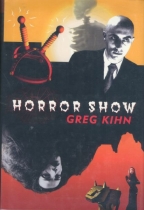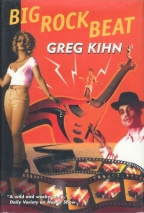The Horror Show
Greg Kihn
Tor Books
US Mass Market Paperback
ISBN 0-812-55108-7
274 pages ; $5.99

Big Rock Beat
Greg Kihn
Tor Books
US Hardcover First
ISBN 0-312-86756-5
351 pages; $23.95
Reviewed by Rick Kleffel © 2001

REFERENCES
COLUMNS
|
|
|
The Horror ShowGreg KihnTor BooksUS Mass Market PaperbackISBN 0-812-55108-7274 pages ; $5.99 |
|
Big Rock BeatGreg KihnTor BooksUS Hardcover FirstISBN 0-312-86756-5351 pages; $23.95Reviewed by Rick Kleffel © 2001 |
|
|
REFERENCES |
COLUMNS |
"I love monster movies. And the cheaper they are, the better they are." --Frank Zappa, from Cheepnis on Live at the Roxy and Elsewhere
Movies have a huge power in the world of horror. They can drag the literature up into grocery-store popularity and down into a reactionary sales slump. But the kind of movies that Zappa's talking about are all too rare in today's big-budget world. Greg Kihn, a drive-time rock DJ for KJSO, a San Jose radio station, has purveyed his affection for the B horror movie into two novels detailing the adventures of Landis Woodley, an amalgam of Ed Wood, Roger Corman, William Castle and other talents of the late fifties and early sixties. 'The Horror Show' is primarily set in 1957, during the filming of a horror movie titled 'Cadaver', while 'Big Rock Beat' follows the making of a cheap rock and roll beach movie. In both Kihn has done an admirable job of recreating in prose the feel of a cheap monster movie.
'The Horror Show' starts with - and eventually returns to -- a rather clumsy framing device. In the present day, Clint Stockbern, a reporter for Monster Movie Magazine, is asked by his editor to interview Landis Woodley, now an aged recluse living in a decrepit mansion in the Hollywood hills. He finds a repulsive and rather frightening man who relates to him the story of his most famous movie, 'Cadaver'. Before you can say flashback - or actually, long after you would have liked to say flashback - we're in the 1950's with Woodley and his crew.
Once we're there, the novel becomes even more lively and involving. Woodley's crew, like Woodley, is an amalgam of various 50's personalities. We get a transvestite scriptwriter, a roaring drunken effects man, a straight-laced camera man and a penny-pinching producer. They're shooting a movie that's a day late and more than a few dollars short, and in a moment of inspired madness in the LA County Morgue, use real cadavers in their movie. What they don't know is that the cadaver they're using is the soon to be re-animated body of a Satanist who has become the vessel for a Snake God. Things go downhill from there for reasons both natural and supernatural. Unfortunately, the supernatural angle, which starts out quite well-defined ends up blurring under the demands of the story.
Kihn's prose captures the clumsy appeal of a 1950's horror movie. He uses the same cheap cuts, the same lame effects and deploys them in the service of a plot that has been around the block more times than the mailman. But he does so with a deliberate glee that will delight fans of these movies. It's only when he breaks out of the past and into the present that he loses some of his innocent joy. But 'The Horror Show' is an admirable and thoroughly enjoyable novel.
Not one to lose the point, Kihn returns to the past in 'Big Rock Beat'. In true B-movie fashion, the framing device is jettisoned and deaths reported in the first novel are negated in the second. 'Big Rock Beat' takes up the story of Woodley and his crew ten years after the filming of 'Cadaver'. This time around, they're making a cheap rock and roll exploitation movie. They run out of money way too soon and are forced to turn to a very shady investor for funds. Before you can say 'bad idea', they're using James Dean's death car and people start dying.
'Big Rock Beat' benefits from our familiarity with and affection for the returning characters and some nicely drawn new additions. Of particular note are a cheesecake model and a producer of Japanese monster movies. The latter is particularly interesting, and the lynch-pin of an excellent plot twist. Once again, the supernatural aspect is rather dodgy, which only slightly detracts from the overall joy of the novel. If things were too serious and well-thought out, it would certainly detract from the B movie vibe. In 'Big Rock Beat', Kihn once again effectively exploits our affection for a time period and his characters. Readers will be glad that he's only as far as the Sixties. That leaves the disaster flicks of the seventies and the slasher flicks of the eighties as fair game. Kihn has the potential to offer us B-movies sequels that are every bit as enjoyable as their predecessors.